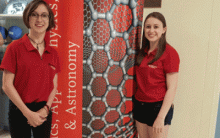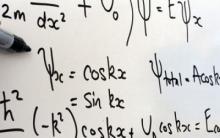For students who demonstrate high achievement both in scholarship and in independent research.
Contribute to new concepts and technologies
The physics department has a vigorous graduate program with approximately 60 students working toward M.S. and Ph.D. degrees. Graduate students develop flexible individual programs of study and research in one or more of the available research areas.
Program of Study
The Ph.D. degree results from following a program of study in physics.
Seventy-two credits beyond the bachelor’s degree are required. A manuscript on the thesis research should be prepared for publication. Admission to the Ph.D. program is granted only upon passing a written qualifying examination by the beginning of the third semester of Rensselaer graduate work. The advanced undergraduate-level exam is given in two parts: 1) Mechanics and Electrodynamics and 2) Quantum Mechanics, Thermodynamics, and Statistical Mechanics. The examination is given twice annually in August and January.
Doctoral requirements do not state a minimum number of course credits. However, students must take the basic core of four courses including PHYS 6410, PHYS 6510, PHYS 6520, and PHYS 6590. Students are expected to obtain a grade of at least B in each of these courses. In addition to the above sequence of core courses, there are the following doctoral course requirements. In addition to these core courses, each student must take 12 additional credits of technical electives at the 4000 and 6000 level, as approved by the student’s adviser and the Graduate Program Committee. Of these 12 credits, at least 6 credits must have a PHYS or ASTR prefix, and at least 6 credits must be at the 6000 level (a single class can be counted towards both requirements). In addition, in satisfying degree requirements, at least two-thirds of the total credit hours, excluding thesis, must contain the suffix numbers 6000-7999, with the further limitation that no more than 15 credit hours of 4000-4990 courses are to be allowed. Students must also pass the Physics Colloquium in four semesters. Note: PHYS 6530 is strongly recommended for all students (all theory students should take this course). There are special requirements for students specializing in astrophysics and biophysics.
Formal continuation in the Ph.D. program is granted only upon passing a written qualifying examination by the beginning of the third semester of Rensselaer graduate work. The advanced undergraduate-level exam is given in two parts:
* Mechanics and Electrodynamics
* Quantum Mechanics, Thermodynamics, and Statistical Mechanics.
The examination is given twice annually in August and January.
Please note that we waive the Ph.D. Qualifying Exam requirement for students who achieve a score of 700 or higher on the GRE Physics subject test, or with an A- or better on our corresponding core graduate courses taken here at RPI.
Once students have chosen a Ph.D. project and assembled a #committee, they will present a brief written thesis proposal to the #committee and orally defend it. In the oral exam, members of the #committee question students specifically on the planned research and more generally on the physics related to that research. This candidacy exam is normally taken at the end of the third year.
Some teaching experience is also required for the Ph.D. degree.
Students who successfully complete this program will be able to:
- demonstrate mastery of core advanced Physics topics through successful completion of courses including Quantum Mechanics, Electrodynamics, and Statistical Physics.
- demonstrate mastery of selected modern topics in Physics, Math, Computer Science, Materials Science, Chemistry, Engineering, or other related fields.
- conduct high-quality original research in their research area with results suitable for journal publications and technical presentations.
- clearly communicate their ideas and results to general and specialized audiences, both orally and in writing.
Financial Aid
There are several potential ways that a graduate student can get financial support while enrolled at RPI. The most common methods are:
PhD students are generally supported for two years on teaching assistantships, followed by two to three years of external support.
Research assistantships are available to many of our graduate students. Tuition is usually also covered. The availability of research assistantships depends upon individual research professors and is subject to the needs of contracts and interests of students. Research assistantships are normally given for the academic year, and in addition, summer support is often also available.
There are various fellowships that can be awarded through the department, inquire within.
Graduate Student Awards
Students are nominated by faculty of the Department of Physics, Applied Physics and Astronomy for the following graduate awards. These awards are presented annually subject to availability of funding.
- Edmond Brown Graduate Prize in Physics: Presented to an outstanding graduate student in Physics, Applied Physics and Astronomy for research in theoretical condensed matter physics.
- Hillard B. Huntington Award: Presented to an outstanding graduate student in Physics, Applied Physics, and Astronomy.
- Paul S. Ho ’65 Graduate Prize in Physics: Presented to an outstanding graduate student enrolled in Physics, Applied Physics, and Astronomy.
- Walter Eppenstein '52 Graduate Teaching Assistant Award: Presented to a graduate student for outstanding contributions to our teaching program in Physics, Applied Physics, and Astronomy.
Facilities
Ever since its inception, Rensselaer has been a leader in science and technology education. Today, the institute provides students with one of the most modern environments for learning.
Students’ thesis research in astronomy and astrophysics enjoys access to world-class ground-based telescopes located at observing sites in the southern hemisphere and China. Our faculty cooperates with the international Large Sky Area Multi-Object Fiber Spectroscopic Telescope (LAMOST), the Sloan Digital Sky Survey, and the very popular MilkyWay@Home project.
For students’ education in observational astronomy and for public outreach, the department maintains the Hirsch Observatory. It houses a fully automated Boller and Chivens 16" Cassegrain Telescope, a Quantum Scientific Imaging (QSI) imaging camera with filter wheel, and a Santa Barbara Instrument Group (SBIG) spectrograph. Many smaller telescopes are also available to students.
State-of-the art equipment for graduate students’ experimental research in optics and condensed matter physics is provided in the physics department. The equipment includes optical, electronic, and cryogenic instruments, surface science techniques and materials growth equipment. Examples are Atomic Force Microscopy, Auger Electron Spectroscopy, Ellipsometry, High-Resolution Low Energy Electron Diffraction, Reflection High-Energy Electron Diffraction, X-Ray Crystallography, and Super-Resolution Microscopy. Also available for research are terahertz radiation sources and ultrafast laser systems. Students engage in absorption, light scattering, and photoluminescence spectroscopy using systems operating from the terahertz frequency band to the ultraviolet part of the electromagnetic spectrum.
Students interested in nanofabrication will find excellent facilities in Rensselaer’s Micro and Nano-Fabrication Clean Room (MNCR). This is a state-of-the-art, 5,700-square-foot, Class 100 multi-user facility which supports research and education in nanotechnology, biotechnology, microelectronics, solid state lighting, energy, and other fields. The MNCR offers infrastructure for end-to-end device fabrication, characterization, metrology and testing by the graduate student user on substrates ranging from a few millimeters in size to full wafers 200 mm in diameter for high-speed electronics, power devices, integrated circuits, microsystems, and other applications. Fabrication of structures as small as 20 nm is possible in the MNCR, and structures as small as 1.5 nm can be achieved. In addition, the facility has several dedicated staff members to provide process solutions, training, and teaching.
The Center for Biotechnology and Interdisciplinary Research on our campus offers extensive and high-quality facilities for students’ experimental research in biological physics at the molecular, cellular and tissue level.
Students conducting research in theoretical condensed matter physics use Rensselaer’s own supercomputer. The Blue Gene/Q is one of the world’s most powerful university-based supercomputers. Theoretical methods implemented by our students on this machine and other computers are density functional theory calculations, Monte-Carlo Simulations as well as classical and quantum mechanical molecular dynamics simulation.
In addition, the Department’s research activities are affiliated with numerous research centers on campus: The Center for Computational Innovations, the Center for Future Energy Systems, the Center for Materials, Devices and Integrated Systems, the Network Science and Technology Center, the Institute for Data Exploration and Applications, the Rensselaer Nanotechnology Center, the Scientific Computation Research Center, the Smart Lighting Engineering Research Center, and the Data Science Research Center.
Rensselaer research in particle astrophysics is involved in one of the leading experiments that could detect neutrinoless double beta decay, the nEXO experiment at SNOLAB in Canada.
Students pursuing thesis research in theoretical particle physics apply lattice field theories and implement the calculations on the Blue Gene/Q supercomputer.

An On-campus organization catering to both undergraduate and graduate students with an interest in physics.

A community of women who seek to support each other through mentoring, workshops, and community building events.

Our faculty and students' scholarly achievements are reflected by the awards they have received from a variety of organizations.
